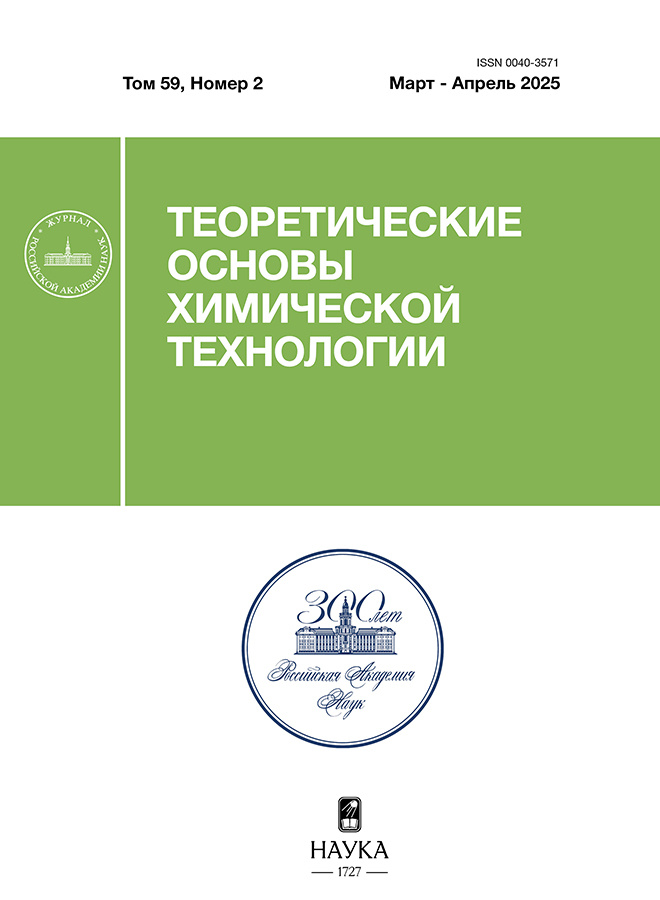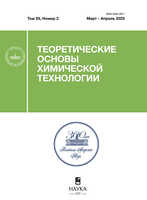Teoretičeskie osnovy himičeskoj tehnologii
Media registration certificate: ПИ № ФС 77 - 83659 от 05.08.2022
Peer-review academic journal has been published since 1967.
Editor-in-chief
- N.N. Kulov, Kurnakov Institute of General and Inorganic Chemistry of the Russian Academy of Sciences (Moscow).
Founders
- Russian academy of sciences
- Kurnakov Institute of General and Inorganic Chemistry of the Russian Academy of Sciences (Moscow)
Publisher
- Russian academy of sciences
About the Journal
Theoretical Foundations of Chemical Engineering is a comprehensive journal covering all aspects of theoretical and applied research in chemical engineering, including transport phenomena; surface phenomena; processes of mixture separation; theory and methods of chemical reactor design; combined processes and multifunctional reactors; hydromechanic, thermal, diffusion, and chemical processes and apparatus, membrane processes and reactors; biotechnology; dispersed systems; nanotechnologies; process intensification; information modeling and analysis; energy- and resource-saving processes; environmentally clean processes and technologies.
Indexing: Russian Science Citation Index, CrossRef, Web of Science (translated version), Scopus (translated version).
Edição corrente
Volume 59, Nº 2 (2025)
- Ano: 2025
- ##issue.datePublished##: 15.04.2025
- Artigos: 11
- URL: https://vietnamjournal.ru/0040-3571/issue/view/13849
Edição completa
Articles
Extraction of metals from nitrate solutions by deep eutectic solvent di(2,4,4,4-trimethylpentyl)phosphinic acid/phenol
Resumo
The qualitative and quantitative composition of NdFeB magnet has been established, the features of metal leaching by nitric acid solution have been studied. Optimal conditions of the process of the most complete leaching of metals were selected. A hydrophobic deep eutectic solvent based on di(2,4,4-trimethylpentyl)phosphinic acid (DTMPPA) and phenol was proposed as an extractant for the extraction of a series of metals from the nitric acid solution of neodymium magnet leaching. Experimental data on the extraction of Ni, Fe, Al and Cu ions from model individual and mixed solutions by deep eutectic solvent DTMPPA/phenol under varying key conditions of the process: acidity of the medium, concentration of the desalting agent, concentration of components in the eutectic solvent, metal concentration, etc. were obtained. The results obtained indicate the promising application of deep eutectic solvent DTMPPA/phenol for the extraction of Ni, Fe, Al and Cu cations in the processes of waste recycling of magnetic materials.
 3-13
3-13


Research on the composition relationship of aqueous mixtures containing esters and alcohols, with energy efficiency of separation schemes
Resumo
In the article on the example of aqueous systems containing homologs of alcohols and alkyl acetates, the possibility of predicting the energy consumption of technological schemes for the separation of mixtures of different composition is shown. Isomeric structures of schemes of product separation based on the application of conventional and (auto)extractive rectification are proposed. Static parameters of column operation providing the required quality of product streams are determined. The dependence of the change in the total energy consumption of schemes on the molecular weight of homologue components and the composition of initial mixtures has been revealed.
 14-32
14-32


Comparison of temperature and ultrasonic intensification of supercritical fluid extraction using parsnip seeds as an example
Resumo
A comparison of thermal and ultrasonic intensification of supercritical fluid extraction using wild parsnip seeds, a source of plant oil and furocoumarin photosensibilizers, was conducted. It was observed that, even at pressure as high as 300 bar temperature effect on parsnip extraction demonstrates a so-called retrograde behaviour, that is, isobaric temperature increase leads decrease in extraction speed and overall mas yield. A previously proposed idea on a chromatography-like mechanism of a supercritical fluid extraction process with multiple re-adsorption of the isolated components onto the plant material working as a sorbent allows explaining the observance of retrograde behaviour, uncommon for such high pressure values. The overall influence of ultrasonic intensification of extraction process was shown to be similar to that of temperature. At low extraction pressure (100 bar), when cavitation of a subcritical fluid entering the extraction zone is principally possible, ultrasonication leads to an increased extraction kinetic at the initial, linear part of the extraction curve. At high working pressure (300 bar), effect of ultrasonication is essentially equal to that of direct heating. Using supercritical fluid chromatography, Furocoumarin profiles of thermal and ultrasonic parsnip extracts were shown to be identical by means of supercritical fluid chromatography, thus, ultrasonication even at 100 bar does not cause any unwanted sonochemical effects.
 33-46
33-46


Using cell-automation approach to create digital twins of hierarchical porous structures
Resumo
This paper proposes a multiscale model based on a cellular-automation approach for generating digital doubles of porous hierarchical structures of sodium alginate-based aerogels. The proposed model utilizes a cell-automation approach to generate structures at meso- and macro-levels and then combine them into a single digital multiscale structure that contains both meso- and macro-pores. Samples of sodium alginate-based aerogels have been experimentally investigated. Computational experiments have been carried out to generate digital structures corresponding to the experimental samples obtained. Comparison of the structural characteristics of digital and experimental samples was carried out, on the basis of which conclusions were drawn about the correct operation of the model. The obtained digital multiscale structures can be used in the future to predict the properties of hierarchical structures, which will partially replace in situ experiments with computational ones and, therefore, reduce costs in the development of new materials with specified properties.
 47-57
47-57


Sorption separation of niobium-zirconium cations mixture
Resumo
The work shows for the first time the possibility of using sorption technologies to separate a mixture of radioactive niobium and zirconium cations, which are part of the waste generated in the nuclear fuel cycle. The separation of these atoms will significantly reduce the costs of waste disposal, as well as provide an opportunity to reuse zirconium ions. In this work the process of ion separation using anion exchanger AB-17-8 is investigated in detail, conditions for more effective realization of the process under dynamic conditions are selected and its mechanism is proposed.
 58-64
58-64


Influence of longitudinal diffusion on technological parameters of drum dryer
Resumo
On the basis of differential equations of material balance and mass transfer for dried material and drying agent the equations of working and equilibrium line at countercurrent motion of phases in a drum dryer are derived. The algorithm of calculation is offered and comparison of technological parameters of drying process taking into account longitudinal diffusion with similar parameters calculated by the typical algorithm is carried out. Graphs of the obtained results in oblique Ramsin diagram and rectangular Euler coordinates are given. It is shown that taking into account the Peclet number of longitudinal diffusion, that is, the transition from the displacement mode to the longitudinal mixing mode, the calculated length and volume of the drum should be increased by 1.1 and more times at Pe< 30.
 65-78
65-78


Flow structure at floating of a single bubble in a liquid with solute surfactant
Resumo
The results of mathematical modeling of the nonstationary problem of gas bubble surfacing in a viscous liquid with a solute dissolved in it are presented. The problem formulation is written taking into account the adsorption and desorption effects of the surfactant at the interface and the dependence of the surface tension coefficient on concentration according to Langmuir’s law. The numerical algorithm of the solution is based on the original Lagrangian-Eulerian technique, which allows us to explicitly allocate the free surface at the discrete level and realize natural boundary conditions on it. The process of establishing the stationary velocity of bubble surfacing is studied, and parametric research on the influence of the surfactant concentration and bubble size on the stationary velocity and flow structure in its vicinity is performed. The distributions of the velocity vector and surface concentration along the interface are presented, demonstrating the influence of the Marangoni effect on the surfacing process.
 79-89
79-89


Concentration distribution of molecules and particles in a chromium-containing model system: Fe-K2Cr2O7-NaCl-H2SO4-H2O at different temperatures of electrocoagulation process
Resumo
Thermodynamic modeling of the electrocoagulation process in the system Fe-K2Cr2O7-NaCl-H2SO4-H2O at wide limits of temperature change (278-300 K) has been carried out for the purpose of water purification from chromium (Cr6+). Physicochemical (pH, I, Eh, Cp) and thermodynamic (H, S, U, G) parameters of the system at the established optimal ratios of the initial components have been calculated. Taking into account the calculated data the experimental research was carried out and the influence on the electrocoagulation processes was revealed: pH, current, type and concentration of electrolytes. The concentration distribution of individual molecules and particles (cations, anions) was established, including: Cr2+, Cr3+, CrO+ , CrOH2+, Fe+ , FeOH+, FeOH2+ in solution and thereby eliminating the use of ion chromatography for analytical purposes. An Eh-pH diagram showing the fields of presence of various forms of chromium has been drawn up, and a formula for calculating the value of the redox potential as a function of solution pH has been obtained. It is shown that Eh> 0, i.e., the medium is oxidizing, and the formation of Cr3+ in concentrated solution (I > 0.8) was observed. The electrocoagulation process achieved the binding of sulfur and iron in the form of FeS2 and followed by the production of Fe(ОН)3 and co-precipitation of Cr(OH)3. The degree of water purification from chromium was more than 97% (reduction of Cr6+in water from 100 mg/L to 2.29-2.30 mg/L).
 90-99
90-99


Mathematical modeling of binary coalescence process of oil-water emulsion droplets
Resumo
The paper presents an attempt to form a general approach to mathematical modeling of binary coalescence arising due to droplet deposition in a gravitational field based on the population balance equation, which can be further applied to predict the conditions of oil-water emulsion stratification. Using experimental curves of water content change over time in water-in-oil emulsions measured at different temperatures, four different ways of calculating the efficiency of binary coalescence are compared.
 100-110
100-110


Experimental research of the kinetics of the reaction of hydrochloric acid with carbonate rocks under thermobaric bed conditions
Resumo
Interaction of acid with carbonate rocks is the basis for the processes of increasing productivity of producing wells and intensification of oil production from carbonate reservoirs. Dissolution of carbonates under conditions of filtration of acid solution through porous medium is determined by competition of chemical reaction processes and convective transfer of acid. Research on these competing processes is carried out in two main setups: a rotating carbonate disk washed by acid flow and an acid solution filtration setup through carbonate reservoir samples. The paper presents the results of such research with discussion of results and discussion of the reaction kinetics parameters on a sample of a particular field. The values of diffusion and reaction kinetics, critical rate of wormhole formation in porous medium at different concentrations of hydrochloric acid have been calculated. The values of the main dimensionless similarity complexes: Damköhler and Peckle numbers and acid solubility were estimated.
 111-120
111-120


Method of model building for estimation of quality parameters of fractionation column products under conditions of small volume of analytical control data
Resumo
The problem of improving the accuracy of models for estimating the low-temperature properties, flammability and anti-wear properties of the target products of the fractionation column under conditions of a small amount of analytical control data is considered. For the solution of the considered problem the method of model building is proposed, which includes the algorithm of expansion of a small training sample on the data of fractional composition, differing in the way of selection of additional data, taking into account the sparsity indicator, which allowed to include the missing amount of data in the training sample, and as a result to ensure the improvement of the model quality. The use of the proposed method improved the accuracy of the models by 18% on average compared to the known methods and by 6% on average compared to the method based on the expansion of the training sample without taking into account the sparsity index. The results are presented on examples of model building of quality indicators of filterability limit temperature, flash point, kinematic toughness at 40°C and cetane number of middle distillate (diesel fuel fraction) and flash point of kerosene fraction of industrial fractionation column of hydrocracking process unit.
 121-137
121-137













